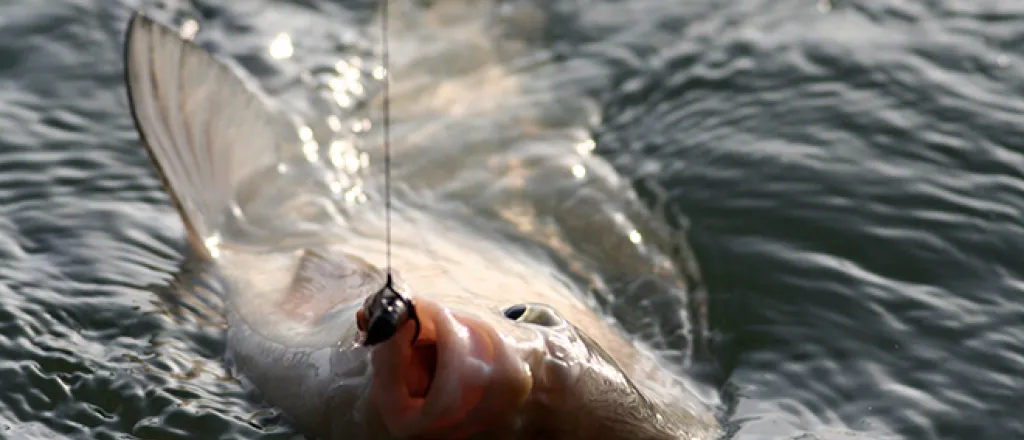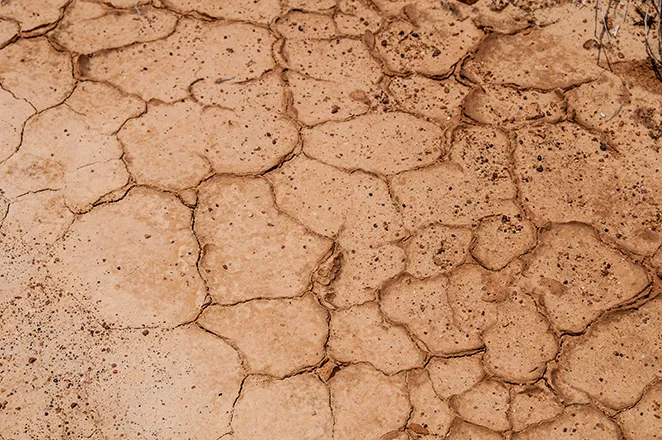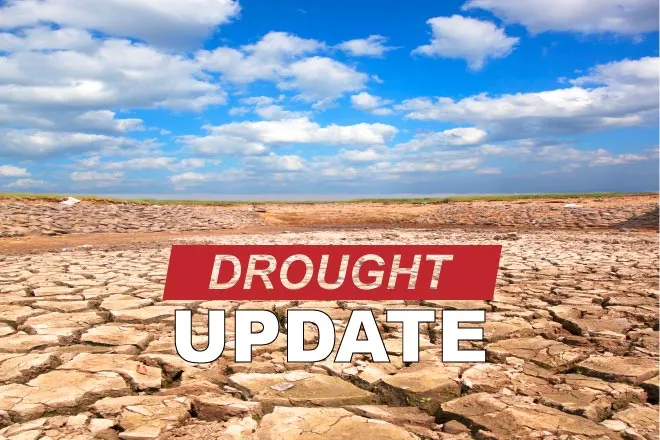
2016 Lower Arkansas River Basin Fishing Forecast
John Martin Reservoir (currently about 9200 acres)
Due to heavy runoff and large precipitation events during spring/summer 2015, John Martin filled to very high levels. At one point, John Martin contained over 300,000 acre ft. of water. Late summer releases lowered the lake to less than 200,000 acre ft., but winter storage has since filled the lake to around 240,000 acre ft. The lake should be around this level for spring fishing in 2016. These levels are 2x – 3x higher than any water levels seen in the last 15 years at John Martin. The large amount of water bodes well for fishing in 2016. Newly flooded habitat provides fish species with the opportunity to expand their range and dramatically increase in number due to increased spawning success. The effect of the higher water levels has already been demonstrated with a huge year class of white bass. These fish are very abundant and should provide excellent angling opportunity in 2016. Historically, high water levels at John Martin have equated to good year classes of crappie as well. Areas that have provided good crappie angling in the past should be productive in 2016. The rocky dam face, the Rule Creek railroad trestle and the numerous coves on the north side should be good places to fish for crappie. Saugeye/walleye fishing should improve as year classes of these stocked fish continue to grow. A short-lived disease setback caused some mortality of young saugeye/walleye in 2015. Larger fish were unaffected. Good numbers of these fish will be available to anglers in 2016, and the stocking program should bring more fish along rapidly. Saugeye/walleye grow quickly in John Martin’s productive waters. Wiper fishing should improve, as stocking success was evident in 2015, and fall sampling showed that good numbers of these fish should be available in 2016. Stocking of wipers will continue as supplies allow. These fish also grow very quickly at John Martin, due to the large population of gizzard shad available for forage. Wipers tend to intermingle with white bass until they reach larger sizes. Fishing for catfish may be a bit more difficult in 2016. The large lake will spread out existing populations. Natural reproduction should increase and supplemental stocking will improve numbers so that fishing for catfish should improve quickly over the next few years.
A couple of regulation changes will be in effect in 2016. The special regulation for walleye/saugeye has been removed. The daily bag/possession limit for walleye/saugeye will be 10 fish with no size restriction. The road 19 boat ramp (west end) will be open to boaters, but pre-launch boat inspections will be required to prevent the spread of aquatic invasive species. Inspections can be obtained at the inspection station located near the visitor’s center at the state park.
Nee Noshe Reservoir (about 500 acres)
In 2015 some flood and irrigation water was stored at Nee Noshe. Also, CPW purchased a large amount of water to be added to the inflows. This has resulted in partial filling of the lake. Although the lake is still low, enough water has been stored to begin rebuilding the fishery. Species stocked in 2015 included: black crappie, channel catfish, largemouth bass, redear sunfish, and gizzard shad (forage). Plans for 2016 include adding walleye, saugeye, and wiper.
Hopefully, much more water will be added in 2016 to completely refill the lake. Historically, Nee Noshe has been touted as one of the best warm-water fisheries in CO. Although still in its infancy, the fishery at Nee Noshe is well on its way to a comeback!
Nee Gronde Reservoir (< 500 ac)
Currently, no fishery exists at Nee Noshe due to low conditions and poor water quality.
Adobe Creek Reservoir (Blue Lake) (about 3500 acres)
Very high water levels persisted at Blue Lake for the majority of 2015, as large amounts of irrigation water were stored at the reservoir. The effects of the high water had an impact on fishing success, especially for catfish. Although the large amounts of water will be very beneficial in the long-run, the large lake tended to spread out the catfish, making them difficult to find and catch. In 2015, large numbers of blue catfish were stocked and good spawning success of channel catfish is anticipated. Numbers of catfish should be vastly improved in 2016, resulting in better catches this year, and in years to come. Crappie fishing was excellent in 2015 and should be great again in 2016. Good numbers and sizes of fish are present and should provide
Page 13
Lower Arkansas River Basin (continued)
great crappie action. Anglers tend to find these fish near the outlet canal, around the island, or near the submerged trees and brush on the north side. During high water years, the outlet canal can be totally flooded. Boaters able to find the canal with their fish-finders may be most successful. Also present at Blue Lake is a healthy population of walleye/saugeye. These fish are especially abundant in the 12”-14” range, and fish up to 27” are common. Historically, anglers primarily target only the crappie and catfish at Blue Lake. Anglers should not overlook the opportunity for good catches of walleye/saugeye. The special regulation for walleye/saugeye has been removed. The daily bag/possession limit for walleye/saugeye will be 10 fish with no size restriction.
Two Buttes Reservoir (about 700 acres)
Since filling in August of 2013, Two Buttes has developed into an outstanding fishery. Good numbers of largemouth bass (up to 18”) were abundant in 2015, as well as large numbers of crappie (up to 9”). Another very positive trend is the development of the bluegill population. These fish have grown quickly, with 6”- 8” fish weighing over 1/2 lb. being common. Good numbers of saugeye, wiper, and channel catfish were also stocked. These fish have also grown quickly and should provide great action in 2016. As an added bonus, catchable rainbow trout were stocked in the fall. These fish have grown over winter and should provide the opportunity to catch trout in the 14”-16” range.
As a reservoir built on an ephemeral creek, Two Buttes relies on heavy precipitation events to maintain its water supply. Evaporative losses and dam seepage can quickly lower the water levels. A good recharge is needed in 2016 to maintain a quality fishery. Anglers are encouraged to enjoy this lake while it is available, as the future is uncertain.
In 2016, Baca County will be added to the list of counties in SE CO in which baitfish transport is legal. Anglers can use legal methods to obtain baitfish in Otero, Bent, Crowley, Kiowa, Prowers, and Baca counties. These fish may be transported and used as bait in any water within this 6-county area. Anglers are strongly encouraged to read and understand the baitfish regulations (listed in the fishing brochure) prior to transporting any baitfish.
Turks Pond (55 acres)
The fully functioning well at Turks Pond has been able to maintain high water levels for the past few years. As a result, fish populations have improved, especially crappie. Summer sampling in 2015 revealed good numbers of crappie at Turks. Historically, Turks has been known as a good channel catfish destination.
While this continues to be true, in recent years, anglers have had to deal with a large population of black bullheads in the pond. Efforts to thin the bullhead population have been effective, but catfish anglers may have to deal pesky bullheads again in 2016. Anglers are asked to voluntarily keep all bullheads caught and refrain from releasing any bullheads back into the water. A small number of tiger muskies and wipers have been stocked in an effort to control future bullhead numbers. Also, mechanical removal projects have helped lower existing numbers. Other species available at Turks include: bluegill, largemouth bass, saugeye, and rainbow trout (seasonal).
In 2016, Baca County will be added to the list of counties in SE CO in which baitfish transport is legal. Anglers can use legal methods to obtain baitfish in Otero, Bent, Crowley, Kiowa, Prowers, and Baca counties. These fish may be transported and used as bait in any water within this 6-county area. Anglers are strongly encouraged to read and understand the baitfish regulations (listed in the fishing brochure) prior to transporting any baitfish.
Meredith Reservoir (3000+ acres)
The fishery at Meredith is making a strong comeback since the lake was drained in 2013. Fall sampling revealed good numbers of some game fish species at Meredith, especially wipers and saugeye. The fish population is currently dominated by species considered as “rough” (carp, bullheads, suckers, etc.). These fish enter the lake in large numbers as the lake is filled. As stocking success increases, the relative abundance of these species tends to decrease in favor of more desirable species.
Page 14
Henry Lake (1000 acres)
Lower Arkansas River Basin (continued)
Similarly to Meredith, Henry was drained in 2013. Since refilling in late 2013, Henry has been restocked with black crappie, blue catfish, channel catfish, largemouth bass, saugeye, wipers, and gizzard shad (forage). Fall sampling in 2015 showed good numbers of saugeye and wiper, along with growing populations of crappie and catfish. One a side note, Henry currently contains large numbers of very big crawdads. Trapping should be very successful until numbers are depleted or game fish species begin to control these crawdad populations.
Thurston Reservoir (< 100 acres)
Water levels continue to be too low to support a fishery. If water levels improve, a fishery will be re- established.
Midwestern Farms Pond (35 acres)
Early in the spring of 2015, some heavy rains created a run-off event at Midwestern Farms Pond. The large amount of water entering the pond caused the water to “turn-over”. When this happens, the deep water (with low oxygen levels) is less dense than the water entering the pond. The denser water sinks, forcing the deep water up. When this occurs, fish kill events can sometimes take place. Such was the case at Midwestern during spring 2015. Unfortunately, a significant number of trout, catfish, saugeye and striped bass perished. Luckily, the kill was short-lived, and most of the fish survived. Fishing was fair to good for the remainder of 2015. Fall sampling showed that good numbers of crappie, catfish, saugeye and wipers currently inhabit the pond. Other abundant species include largemouth bass, smallmouth bass, bluegill, sunfish, and rainbow trout (seasonal). All species except smallmouth bass and sunfish are stocked yearly by CPW.
As a former gravel pit, Midwestern Farms Pond is severely lacking in natural habitat. These pits tend to be nothing more than gravel bottomed bowls filled with water. As such, additional aquatic habitat needs to be provided and maintained. Several habitat structures have been installed in the pond. Some are marked with large white buoys. Many more exist that are unmarked. Anglers that can locate these fish attracting structures have a good chance of being successful.
Northgate Ponds #1 (9 acres), #2 (7 acres), and #3 (15 acres)
Northgate Park is located on the north side of Lamar at the old Valco cement plant. The park contains 3 reclaimed gravel pit ponds that are stocked for fishing. Until recently, only pond #1 was open for fishing. Early in 2016, ponds #2 and #3 were opened for public access (walk-in only). All 3 ponds provide good opportunity to catch several warm-water species as well as trout in the spring, fall, and winter. Stocked species include: largemouth bass, smallmouth bass, channel catfish, blue catfish, black crappie, bluegill, redear sunfish, wiper, and rainbow trout. Of these species, smallmouth bass, channel & blue catfish, and rainbow trout have been stocked as adult (catchable) sizes. Some of these have been stocked as brood fish, and provide anglers an opportunity to catch a fish of trophy size. Also, several habitat projects have been conducted that involve the creation of numerous natural and artificial tree structures. These structures attract fish and are good places to try your luck. Some of these structures are marked with white buoys.
Northgate Park is undergoing several projects to create a family-friendly environment. As the recipient of a “Fishing is Fun” grant, many facilities and amenities will be constructed in the near future to make Nothgate Park and enjoyable place to take a kid fishing.
Jackson’s Pond (Eads, CO) (8 acres)
Jackson’s Pond is an 8 acre pond located about 1⁄2 mile south of the town of Eads, CO. Originally a privately owned farm pond, Jackson’s Pond has become a popular public fishing spot since being acquired by the Kiowa County Economic Development Foundation in 2004. Several projects to improve the pond have taken place since the acquisition. The initial project dealt with cattail removal and dredge work to deepen the pond. Also, fishing access points, picnic areas, and a restroom were added. Trees were planted and roads and trails were built to improve access. A second, smaller fishing is fun project was granted to improve the dam and
Page 15
Lower Arkansas River Basin (continued)
raise the spillway, and to haul off dredge material from the first project. Finally, a third phase began in 2010 to construct a handicap accessible fishing pier and to install rip-rap rocks to the dam structure. The result is a very user-friendly fishing pond where families can enjoy a fun outing. Much of this work was the vision of long-time Eads resident, Rod Johnson. Rod was a member of the Kiowa County Economic Development Foundation and almost single-handedly directed this project. Rod passed away in December of 2013. He continues to be missed tremendously.
Fish species stocked at Jackson’s Pond include: largemouth bass, smallmouth bass, bluegill, channel catfish, and yellow perch. Also available are black crappie and green sunfish. The crappie tend to become overabundant and stunted, so removal projects have focused on reducing crappie numbers at Jackson’s Pond. Anglers are encouraged to harvest all crappie caught. Grass carp are also stocked to assist in controlling aquatic vegetation. These fish can grow quite large. Rarely, a grasser will take an angler’s offering. When that happens, the lucky angler is in for quite a battle.
Holbrook Reservoir (675 acres)
In recent years, Holbrook has been completely drained and refilled several times during irrigation practices. Unfortunately, that doesn’t work well for fishery management. Holbrook will not be restocked until a more stable water management program becomes established.
Upper Queens Reservoir (1200 Acres)
Queens Reservoir had been dry since 2005. In summer of 2015, a large amount of irrigation water was diverted north from the Arkansas River to Queens. Since then, additional water has been added through the winter storage program. Currently, Upper Queens has very good water levels, and Lower Queens contains plenty of water as well. Fish stocking began almost immediately upon receiving water. Species stocked include: black crappie, blue catfish, channel catfish, largemouth bass, redear sunfish, saugeye, walleye and gizzard shad (forage). Wipers will be added in 2016 as supplies allow. Historically, Upper Queens has been a tremendous warm-water fishery. Fish should grow very quickly in the productive new-lake environment. Plenty of aquatic habitat exists among the freshly flooded tamarisk, cottonwood, and Russian olive trees. It would not be surprising if catchable sized fish existed at Queens by fall 2016.
Horse Creek Reservoir (Timber Lake) (2500 Acres)
Timber Lake had been dry since the early 2000s. The lake was refilled and stocked in 2015. Timber is a large lake with plenty of fish habitat. The future of Timber Lake is very dependent on the prevailing climate. If a wet cycle exists, Timber will remain filled. However if a dry cycle persists, Timber is usually one of the first lakes to be drained. Species stocked in 2015 include: blue catfish, channel catfish, black crappie, bluegill, largemouth bass, and gizzard shad (forage). Saugeye and wiper will be added in 2016 as supplies allow. As with Queens, fish should grow quickly in this new lake environment.
Public shoreline access is somewhat limited around Timber Lake. Be sure to stay within the marked boundaries. It is recommended that anglers consult the maps contained on the CPW website.
S.E. COLORADO BOATERS:
Most of the lakes in SE CO have boat ramps available to the public. The majority of these ramps do not have any boat inspectors present. By law, all boats coming in from out-of-state must be inspected at a qualified boat inspection facility before launching at any water in Colorado. Although not mandatory, it is a good idea to have all in-state boats inspected as well. The future of boating in Colorado is dependent upon each boater becoming educated in the importance of always maintaining a clean, drained, and dry vessel.
















